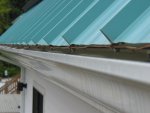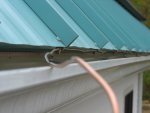Conceptually, it would be a good idea to bond the roof to the PV EGC. I would not bond it to a different electrode than the PV array. Use the same electrode as the PV array, which ideally should be the premises electrode system.
With that said, I think you will find it difficult to source hardware that is listed for bonding standing seam roofs. The catch-22 is that the protective anti-corrosive coating of the roof panels isn't supposed to be penetrated, and you can't bond from the top without doing that. So any company advertising a method for bonding would also be advertising that your roof panel warranty would be void.
Your best bet might be products intended for lightning protection systems.
Finally, I think that in practice, if the PV panels are mounted using something similar to S-5! clamps, you'll probably have a lot of bonding between the PV panels and roof, even if the clamp manufacturer won't admit it. Experience makes me somewhat inclined to say 'don't worry about it'. On the other hand, my observations have withstood neither the test of a few months exposure to the elements, nor the scrutiny of any inspector asking for an approved bonding method.



